President Donald Trump announced on Tuesday that the United States has finalized a trade agreement with Indonesia, although he provided limited details about the deal’s depth, terms, or when its provisions will take effect.
Trump described the deal as a “great deal, for everybody,” and mentioned his direct dealings with Indonesia’s President, stating, “DETAILS TO FOLLOW!!!” This announcement marks the fourth trade agreement Trump has revealed in just three months. Despite the frequency of these proclamations, many are left questioning the actual progress, as specifics on prior agreements, such as one with Vietnam earlier this month, remain sparse.
Trump’s unpredictable trade policy has created uncertainty for businesses, as many are anxious about potential tariff changes that could significantly affect overseas orders. While the President has suggested that companies could sidestep these issues by relocating production to the U.S., experts argue this transition is far from straightforward. Challenges such as difficulty in finding suitable labor and the significant time and financial investment required to establish domestic manufacturing facilities could complicate these efforts. Additionally, moving production could lead to increased costs that may ultimately be passed on to American consumers.
With Indonesia being America’s 23rd-largest trading partner, data from the U.S. Commerce Department indicates that the U.S. imported $28 billion worth of goods from Indonesia last year, primarily in apparel and footwear, while exporting $10 billion worth, primarily in oilseeds, grain, and oil and gas.
The potential of the new trade agreement could foster stronger economic ties between the U.S. and Indonesia, providing opportunities for growth in various sectors. As the specifics of the deal unfold, it will be crucial to monitor its implications for both nations, especially for American businesses and consumers.
